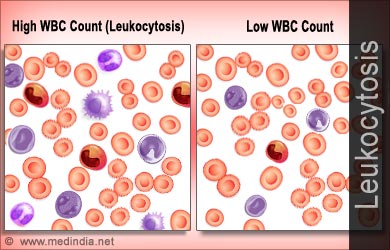Leukocytosis
Leukocytosis, defined as a white blood cell count greater than 11,000 per mm3 (11 X 109 per L), is frequently found in the course of routine laboratory testing. An elevated white blood cell count typically reflects the normal response of bone marrow to an infectious or inflammatory process. Occasionally, leukocytosis is the sign of a primary bone marrow abnormality in white blood cell production, maturation or death (apoptosis) related to a leukemia or myeloproliferative disorder. Often, the family physician can identify the cause of an elevated white blood cell count based on the findings of the history and physical examination coupled with basic data from the complete blood count.Production, Maturation and Survival of Leukocytes Common progenitor cells, referred to as "stem cells," are located in the bone marrow and give rise to erythroblasts, myeloblasts and megakaryoblasts. Three quarters of the nucleated cells in the bone marrow are committed to the production of leukocytes. These stem cells proliferate and differentiate into granulocytes (neutrophils, eosinophils and basophils), monocytes and lymphocytes, which together comprise the absolute white blood cell count. An abnormal elevation in the neutrophil count (neutrophilia) occurs much more commonly than an increase in eosinophils or basophils.

When normal bone marrow responds to inflammation or infection, most of the cells are polymorphonuclear leukocytes.
The cells within the bone marrow compartment are classified into two populations:
- ¾ those that are in the process of DNA synthesis and maturation and
- ¾ those that are in a storage phase awaiting release into the circulating pool.
The circulating pool of neutrophils is divided into two classes. One pool of cells is circulating freely, and the second pool is deposited along the margins of blood vessel walls. When stimulated by infection, inflammation, drugs or metabolic toxins, the deposited cells "demarginate" and enter the freely circulating pool.
Once a leukocyte is released into circulation and tissue, it remains there only a few hours, at which time cell death occurs. The estimated life span of a white blood cell is 11 to 16 days, with bone marrow maturation and storage comprising the majority of the cell’s life.
| Table 1 -Pathophysiologic Mechanisms of Leukocytosis |
|
Normally responding bone marrow |
Etiology of Leukocytosis
The investigation of leukocytosis begins with an understanding of its two basic causes:
1. the appropriate response of normal bone marrow to external stimuli and
2. the effect of a primary bone marrow disorder.
Physiologic mechanisms of leukocytosis are listed in Table 1.





Comments
I did my blood test and my t.wbc count is 77200..pls leme noe wt cud b de possible problem
My daughter age is 4 years 4 months. Her WBC count is 18600 and C reactive protein level is 43.5 mg/L. I want to know what does above results are indicating
tissue necrosis : CIRROSIS 0f hepatic.. well done.. thanx :)
well written and very informative.
leukocytosis can occur due to overt exitation, Severe stress,Burns, Dehydration,Hypoxia,Gangrene and excess of steroids.